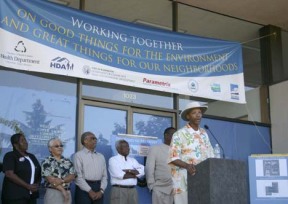Tacoma city leaders gathered Saturday for a ceremony to mark the beginning of construction of a new mixed-use commercial and residential project near the corner of 11th Street and Martin Luther King Jr. Way in Tacoma’s Hilltop neighborhood.
According to Felix Flannigan, executive director of Martin Luther King Housing Development Association, which is leading the development, the project is a culmination of efforts aimed to clean-up the site of an abandoned bank and former gas station, and inject some vitality into the neighborhood. The project was made possible through a combination of federal, state and local resources designed to assess and clean up old filling stations that could possibly pose a risk to county residents, according to MLKHDA.
An inventory of former gas station sites compiled by the Tacoma-Pierce County Health Department in 2003 identified 372 former gas station sites in Pierce County. Most of these sites are in distressed neighborhoods and are concentrated over the aquifers that provide public drinking water in Tacoma.
With funding from the Environmental Protection Agency, Tacoma-Pierce County Health Department launched the Brownsfields Assessment Project, the project goal is to coordinate assessment and redevelopment, and help reduce the threat that some of these former gas station sites posed to the public water supply.
The clean-up program is the joint effort of the Hilltop community, Tacoma-Pierce County Health Department, Martin Luther King Housing Development Association, the Environmental Protection Agency, the State Department of Ecology, the City of Tacoma, Washington State Department of Community, Trade and Economic Development and Parametrix.
The project has conducted environmental assessments on five historic gas station sites and is working with community groups and advisory boards to select other sites for assessment and redevelopment. The Martin Luther King Housing Development Association development at 1023 MLK Jr. Way is the first to begin the construction stage.
When completed, the project will provide 50-60 units of affordable housing, 100,000-square-feet of office and retail space, and parking for 350 vehicles.
“This was a big endeavor, and a lot of people had a lot to do with this project,” said Flannigan. He noted the challenge of developing the former gas station site, which has three gas tanks buried below ground-level. “The state stepped in with the resources and technical assistance on how to remove those tanks.”






